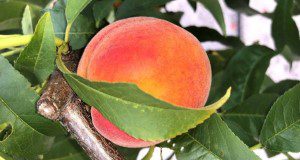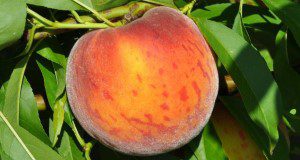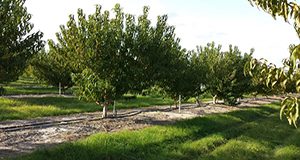El suave clima invernal de Florida y el comienzo de la temprano de primavera ofrecen oportunidades únicas para la producción de duraznos y nectarinas de temporada temprana. Durante los últimos 12 años, la Universidad de Florida ha lanzado muchos cultivares nuevos de durazno y nectarina. Estos nuevos y mejorados cultivares han aumentado el potencial de expansión del aspecto comercial de melocotones y nectarinas en gran parte de la península de Florida y en las regiones de la Costa del Golfo del sureste de los Estados Unidos.
This new 5-page article is the Spanish translation of RFAC018, Alternative Opportunities for Small Farms: Peach and Nectarine Production Review. Written by Ali Sarkhosh, Mercy Olmstead, Jeff Williamson, Jose Chaparro, and Juanita Popenoe, translated by Eva Pabon, and published by the UF/IFAS Horticultural Sciences Department.
https://edis.ifas.ufl.edu/hs1374
Tag: Jose Chaparro
Variedades de Durazno y Nectarina en la Florida
La Universidad de la Florida ha desarrollado cultivares de nectarina y durazno de alta calidad, bajo requerimiento de horas frio, y de maduracion temprana que pueden cultivarse desde el Panhandle de la Florida (noroeste del estado) tan al sur como Immokalee. Cultivares de bajas horas frio pueden crecer y producir fruta bajo las condiciones de la Florida que son mucho mas calidas en el invierno que en estados mas al norte. This 18-page fact sheet, translated by Tatiana Sanchez and published by the UF/IFAS Horticultural Sciences Department, is the Spanish-language version of CIR1159, Florida Peach and Nectarine Varieties, written by Ali Sarkhosh, Mercy Olmstead, Jose Chaparro, Pete Andersen, and Jeff Williamson.
https://edis.ifas.ufl.edu/hs1346
Rootstocks for Florida Stone Fruit
Rootstocks are used in many tree fruit systems to provide growth advantages and/or pest and disease resistance without affecting (sometimes improving) productivity and fruit quality. This 6-page document discusses the use of rootstocks for Florida stone fruit. Written by Ali Sarkhosh, Mercy Olmstead, Jose Chaparro, and Thomas Beckman and published by the UF/IFAS Horticultural Sciences Department, November 2018.
http://edis.ifas.ufl.edu/hs366
Irrigation Practices for Peaches in Florida
This 6-page document provides basic information and guidelines on water requirements and irrigation strategies for peaches grown in Florida. Written by C. Zambrano-Vaca, L. Zotarelli, K. Migliaccio, R. Beeson Jr., K. Morgan, J. Chaparro, and M. Olmstead and published by the UF/IFAS Horticultural Sciences Department, April 2018.
http://edis.ifas.ufl.edu/hs1316
Florida Subtropical Peaches: Production Practices
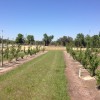 Subtropical peach production includes many practices, such as site selection, orchard design, and disease, weed, and insect management through to harvest. Florida’s subtropical climate allows growers to harvest their crops early, but it creates challenges for the long postharvest growing season. This 14-page fact sheet covers the breadth of topics related to subtropical peach production, including a monthly timeline of recommended practices. Written by M. Olmstead, J. Chaparro, J. G. Williamson, R. Rouse, R. Mizell, P. Harmon, and J. Ferguson, and published by the UF Department of Horticultural Sciences, August 2013.
Subtropical peach production includes many practices, such as site selection, orchard design, and disease, weed, and insect management through to harvest. Florida’s subtropical climate allows growers to harvest their crops early, but it creates challenges for the long postharvest growing season. This 14-page fact sheet covers the breadth of topics related to subtropical peach production, including a monthly timeline of recommended practices. Written by M. Olmstead, J. Chaparro, J. G. Williamson, R. Rouse, R. Mizell, P. Harmon, and J. Ferguson, and published by the UF Department of Horticultural Sciences, August 2013.
http://edis.ifas.ufl.edu/hs348
Florida Peach and Nectarine Varieties
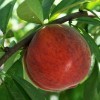 The University of Florida has developed high-quality, low-chilling, early-maturing peach and nectarine cultivars that can be grown from the panhandle of Florida to as far south as Immokalee. Low-chilling cultivars can grow and produce fruit under Florida conditions that are much warmer in winter than in northern states. Furthermore, ripening of these cultivars during April and May ensures an early spring market window for tree-ripe fresh fruit in Florida before peaches and nectarines from other southeastern states and California come to market. Both commercial and dooryard recommended varieties span the growing season. This 8-page fact sheet was written by Mercy Olmstead, Jose Chaparro, Pete Andersen, Jeff Williamson, and James Ferguson, and published by the UF Department of Horticultural Sciences, May 2013.
The University of Florida has developed high-quality, low-chilling, early-maturing peach and nectarine cultivars that can be grown from the panhandle of Florida to as far south as Immokalee. Low-chilling cultivars can grow and produce fruit under Florida conditions that are much warmer in winter than in northern states. Furthermore, ripening of these cultivars during April and May ensures an early spring market window for tree-ripe fresh fruit in Florida before peaches and nectarines from other southeastern states and California come to market. Both commercial and dooryard recommended varieties span the growing season. This 8-page fact sheet was written by Mercy Olmstead, Jose Chaparro, Pete Andersen, Jeff Williamson, and James Ferguson, and published by the UF Department of Horticultural Sciences, May 2013.
http://edis.ifas.ufl.edu/mg374
Rootstocks for Florida Stone Fruit (HS1110/HS366)
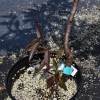 Rootstocks have been used in many tree fruit systems to provide growth advantages or pest or disease resistance without affecting productivity and fruit quality. In Florida, stone fruit are grown on rootstocks that specifically provide pest resistance to the peach root-knot nematode. Although several root-knot nematode-resistant rootstocks are available for stone fruit grown in other locations and climates, ‘Flordaguard’ peach rootstock is currently recommended for stone fruit production in Florida. This 5-page fact sheet was written by M. Olmstead, J. Chaparro, and J. Ferguson, and published by the UF Department of Horticultural Sciences, November 2012.
Rootstocks have been used in many tree fruit systems to provide growth advantages or pest or disease resistance without affecting productivity and fruit quality. In Florida, stone fruit are grown on rootstocks that specifically provide pest resistance to the peach root-knot nematode. Although several root-knot nematode-resistant rootstocks are available for stone fruit grown in other locations and climates, ‘Flordaguard’ peach rootstock is currently recommended for stone fruit production in Florida. This 5-page fact sheet was written by M. Olmstead, J. Chaparro, and J. Ferguson, and published by the UF Department of Horticultural Sciences, November 2012.
http://edis.ifas.ufl.edu/hs366
Alternative Opportunities for Small Farms: Peach and Nectarine Production Review (RFAC018/AC018)
 Florida produces some of the earliest commercial-quality peaches and nectarines in North America. During the last 10 years, many new, improved peach and nectarine cultivars have been released by the University of Florida. They have increased the potential for expansion of commercial peach and nectarine acreage throughout much of the Florida peninsula and along the Gulf Coast regions of the southeastern United States. This 3-page fact sheet was written by Mercy Olmstead, Jeff Williamson, Jose Chaparro, and Tim Crocker, and published by the UF Department of Horticultural Sciences, September 2011.
Florida produces some of the earliest commercial-quality peaches and nectarines in North America. During the last 10 years, many new, improved peach and nectarine cultivars have been released by the University of Florida. They have increased the potential for expansion of commercial peach and nectarine acreage throughout much of the Florida peninsula and along the Gulf Coast regions of the southeastern United States. This 3-page fact sheet was written by Mercy Olmstead, Jeff Williamson, Jose Chaparro, and Tim Crocker, and published by the UF Department of Horticultural Sciences, September 2011.
http://edis.ifas.ufl.edu/ac018
